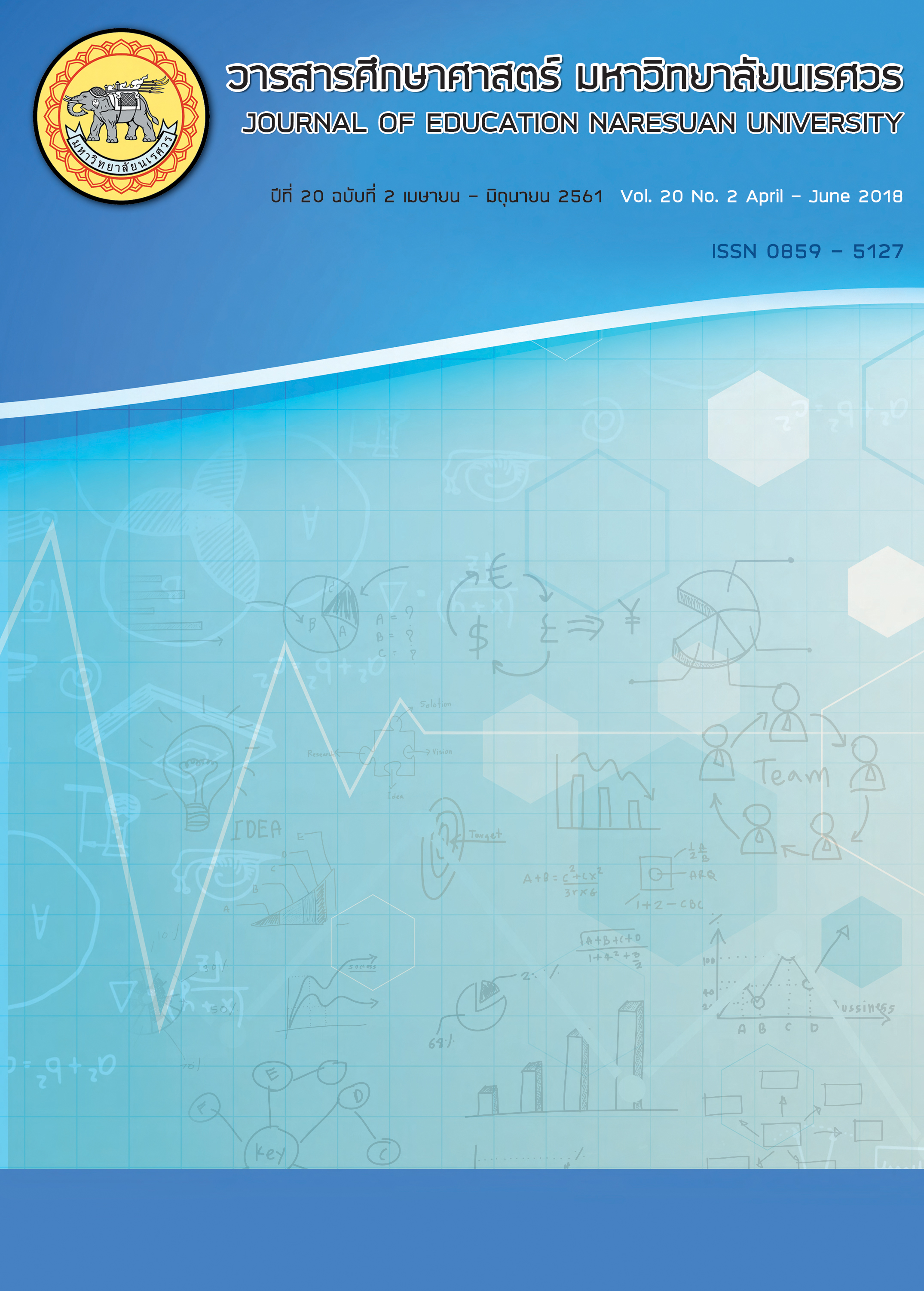HOW GENERATIVE GRAMMAR HELPS BUILD SENTENCE SKILLS FOR THAI STUDENTS: A COGNITIVE APPROACH TO TEACHING WRITING
Main Article Content
Abstract
Although the teaching of EFL writing in Thailand has mostly focused on the grammar and structure of the language, it may not have sufficiently demonstrated to students how the knowledge about sentence parts and sentence patterns explained by generative grammar (GG) may be useful in coping with the differences between Thai and English sentences. Generative grammar is a structuralist and cognitivist approach to make students visualize not only how sentence parts are arranged together to form complete and grammatical sentences but also how modifying phrases or clauses are tied to core sentence parts to get rid of redundancies as well as to achieve clarity. Cognitive theory supports generative grammar in that it helps students to imagine the locations of sentence parts and imprint them in their memory. However, generative grammar and cognitive theory are only the first half of learning English in the country. EFL writing teachers must incorporate the social aspect of learning, which in learning a language refers to the practice.
Article Details
The owner of the article does not copy or violate any of its copyright. If any copyright infringement occurs or prosecution, in any case, the Editorial Board is not involved in all the rights to the owner of the article to be performed.
References
Ahmad, S., & Rao, C. (2013). Applying communicative approach in teaching English as a foreign language: A case study of Pakistan. Porta Linguarum, 20. Retrieved from https://www.ugr.es/~portalin/articulos/PL_numero20/12%20%20Saeed.pdf
Asl, E. H. (2015). Comparative study of Grammar Translation Method (GTM) and Communicative Language Teaching (CLT) in language teaching methodology. International Journal of Science and Research Methodology, 1(3), 16-25.
Badger, D. (n.d.). Importance of grammar. Retrieved from https://webboard.sport.sanook.com/ forum/index.php?topic=3861184.msg19474210#msg19474210
Bavali, M., & Sadighi, F. (2008). Chomsky’s universal grammar and Halliday’s systemic functional linguistics: An appraisal and a compromise. Pan-Pacific Association of Applied Linguistics, 12(1), 11-28.
Bergmann, A., Hall, K., & Ross, S. (Eds.). (2007). Language files: Materials for an introduction to language and linguistics. Columbus, OH: The Ohio State University Press.
Bruffee, K. (1997). Collaborative learning and the “conversation of mankind.” In V. Villanueva (Ed.), Cross-talk Comp Theory: A Reader (pp.393-414). Urbana, IL: National Council of Teachers of English.
Conde, X. F. (2005). An introduction to syntax according to generative grammar theories. Romania Minor. Retrieved from https://www.romaniaminor.net/ianua/sup/sup08.pdf
Craven, M. (2009). Reading keys: Skills and strategies for effective reading student book 3. Oxford: Macmillan.
Crowley, S. (1998). Composition in the university: Historical and polemical essays. Pittsburgh, PA: University of Pittsburgh Press.
Dewey, J. (1997). Experience and education. Massachusetts, MA: Free Press.
Eppler, E. D., & Ozon, G. (2013). English words and sentences: An introduction. New York: Cambridge University Press.
Fairclough, N. (1989). Language and power. London: Longman.
Foster-Cohen, S. H. (1999). An introduction to child language development. London: Longman.
Fowler, R. (1991). Language in the news: Discourse and ideology in the press. London: Routledge.
Flower, L., & Hayes, J. (1997). A cognitive process theory. In V. Villanueva (Ed.), Cross- talk comp theory: A reader (pp. 251-275). Urbana, IL: National Council of Teachers of English. Generative grammar. Retrieved from https://en.wikipedia.org/wiki/Generative_grammar
Hart, C., & Luke, D. (2007). Cognitive linguistics in critical discourse analysis. In C. Hart and D. Luke (Eds.), Cognitive linguistics in critical discourse analysis (pp. ix-xiii). Newcastle: Cambridge Scholars Publishing.
Hawkins, R. (2001). Second language syntax: A generative introduction. New York: Blackwell Publishers.
Islam, M. J., & Bari, I. S. (2012). Implementation of CLT in Bangladesh and Thailand: Problems and challenges. Outlooks: VUB, 2(1). Retrieved from https://www.academia.edu/ 5753157/Implementation_of_CLT_in_Bangladesh_and_Thailand_Problems_and_Challenges
Kaewnuch, S. (2012). Balancing structuralism and postructuralism in EFL writing instruction and assessment. Journal of Liberal Arts, Prince of Songkla University “Multicultural, Lifestyle and Language,” 4(1), 39-47.
Kent, T. (1993). Paralogic rhetoric: A theory of communicative interaction. Lewisburg: Bucknell University Press.
Krathwohl, D. R. (2004). A revision of Bloom’s Taxonomy: An overview. Theory into Practice, 41(4), 212-225.
Kusolsong, S., & Sittisomboon, M. (2017). A development of instructional model to enhance metacognitive strategies for Rajabhat University students. Journal of Education Naresuan University, 19(1), 114-130.
Lightfoot, D. (1999). The development of language acquisition, change, and evolution. Malden, MA: Blackwell Publishers.
Mehrpour, S., & Forutan, Ali. (2015). Theories of first language acquisition. Journal of Language, Linguistics, and Literature, 2(1), 30-40.
Pesetsky, D. (1999). Linguistic universals and Universal Grammar. In R. A. Wilson & F. C. Keil (Eds.), The MIT Encyclopedia of the Cognitive Sciences. Cambridge, MA: MIT Press.
Radford, A. (1997). Syntax: A minimalist introduction. Cambridge: Cambridge University Press.
Sommers, N. (1997). Revision strategies of student writers and experienced adult writers. In V. Villanueva (Ed.), Cross-talk comp theory: A reader (pp.43-54). Urbana, IL: National Council of Teachers of English. The Grammar Translation Method. Retrieved from https://eslmethods.wikispaces.com/file/view/The+Grammar+Translation+Method.pdf
Thep-Ackrapong, T. (2005). Teaching English in Thailand: An uphill battle. Journal of Humanities Parithat, Srinakharinwirot University, 27(1), 51-62.
Tomic, W. (1993). Behaviorism and cognitivism in education. Psychology, A Journal of Human Behavior, 30(3/4), 38-46.
Turner, M. (1991). Reading minds: The study of English in the age of cognitive science.
New Jersey, NJ: Oxford University Press.
White, L. (2003). Second language acquisition and universal grammar. Cambridge: Cambridge University Press.
Wodak, R. (2001). What is CDA about¬—a summary of its history, important concepts and its developments. In R. Wodak and M. Meyer (Eds.), Methods of critical discourse analysis (pp. 1-13). London: Sage.


